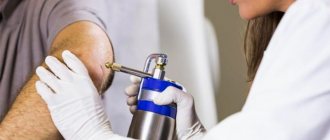Papillomas can be localized in any area of the skin. The most common places for the localization of benign neoplasms of the skin and mucous membranes are the skin of the folds of the neck, axillary zones, inguinal-femoral folds and pubis, genitals and gluteal folds, and perianal zone. This is due to the fact that in these places the skin is most susceptible to friction and the appearance of microtraumas, through which the human papillomavirus (HPV) enters from an infected environment.
The source of HPV infection is a sick person (through direct bodily or sexual contact) and objects contaminated with the virus (towels, washcloths, razors).
The incubation period of human papillomavirus infection ranges from two weeks to several years.
It is also possible that papillomas may appear on the mucous membranes of the lips and mouth, nose, external genitalia, vagina and cervix. With HPV infection of the cervix, dysplasia occurs - changes in the cellular composition of the mucosa, which increases the risk of cervical cancer. There are several dozen varieties of HPV, oncogenic - papillomavirus types 16 and 18, which can be identified by DNA testing (PCR) of a cervical scraping.
In appearance, papillomas on the skin look like neoplasms that protrude above the skin level in the form of hemispherical flat nodules or threads of soft and moderately dense consistency ranging in size from 1 mm to 5–7 mm. Neoplasms can have a “thin stalk” or a wider base. Papillomas usually have the color of the surrounding skin, sometimes there is a pink tint in the lesions.
Papillomas in the area of the external genitalia are called genital warts. They are transmitted through intimate contact (a condom does not always protect against this infection). Condylomas acuminata have the appearance of pink soft elastic formations on a thin stalk with a papillary surface, reminiscent of the appearance of a “cockscomb” or “cauliflower”.
The size of condylomas usually does not exceed 5 mm, but when several elements group and merge, foci of condylomatosis with sizes up to several centimeters are formed.
What studies can be prescribed for a patient with papillomas?
If a patient is diagnosed with papillomas, he is usually prescribed:
- Examination for the full range of sexually transmitted infections: syphilis and HIV, gonorrhea, trichomoniasis, chlamydia, genitourinary mycoplasmosis. This is necessary in the case of genital papillomas. To do this, the patient undergoes blood sampling from a vein and a smear examination for urogenital infections from the lower parts of the genitourinary tract (urethra, vagina, cervix).
- Blood test for sugar, cholesterol and lipid profile, bilirubin and transaminases. A clinical blood test can be offered to the patient to exclude those underlying diseases that served as a prerequisite for the presence of multiple papillomas on the skin or mucous membranes.
- Blood test for cryoglobulins - in case of suspected cryoglobulinemia before using the cryodestruction method.
Women with manifestations of genital HPV infection are prescribed a smear test for oncocytology and colposcopy - an examination of the condition of the cervical mucosa under a magnifying device (colposcope).
Complications and side effects from the cryodestruction procedure
Complications may arise if the patient further stimulates the scab so that it separates from the skin faster. Doctors do not recommend applying exfoliating agents with aggressive components to the scab or picking at it yourself. It is also important to protect the area from chemicals. All this can disrupt the integrity of the shell and activate the virus. In the best case, papilloma will appear again in the treated area in the future. In the worst case, bacteria will enter the body through the damaged area of skin.
Patients did not experience any other complications after the procedure. Sometimes a scar appears at the site of the papilloma or the skin slightly changes color (for example, it becomes lighter relative to the rest of the skin). But these consequences do not affect the patient’s health and disappear without medical intervention in a few weeks.
If the papillomas were large, then swelling or blisters may appear in its place. This is a natural phenomenon: it occurs due to the activation of the immune system.
Stages of cryodestruction of papillomas
Cryodestruction of papillomas does not require special preliminary preparation. Anesthesia is not performed, since there is a short-term exposure to cold on the lesion (from 5 to 40 seconds). Cryodestruction is carried out as follows:
- The patient frees the treatment area from clothing and takes a comfortable position on the couch.
- There are 2 methods of influencing liquid nitrogen on neoplasms: application and aerosol (non-contact). When applying freezing, a cotton swab “on a stick” or tweezers is used, which is lowered into a container with liquid nitrogen and applied to the papilloma for 5–40 seconds. The time and area of exposure to cold are determined by the size of the papilloma. With the non-contact method of cryodestruction, nitrogen is supplied through the tip of a special device (cryodestructor) and sprayed onto the papilloma in the form of an aerosol.
- The process of removing papilloma using liquid nitrogen is gradual (on average up to 2–4 weeks). After freezing, the papilloma tissue mummifies and falls off in the form of a “crust.”
If the effect is insufficient, repeated cryodestruction of papillomas is possible. Skin scarring does not form after a correctly performed cryodestruction technique.
How is papillomas removed with liquid nitrogen?
Before removing papillomas by cryodestruction, the patient undergoes a general clinical examination. This will identify the presence of contraindications, as well as assess the patient’s health status and the characteristics of warts (number, size, location). Comprehensive diagnostics includes:
- Examination by a dermatologist;
- Consultation with an anesthesiologist who will select the most optimal method of administering an anesthetic drug (if necessary);
- Examination by an oncologist (if the wart is suspected of being malignant);
- Laboratory research.
The procedure for removing papilloma by cryodestruction can be performed using a cryoprobe or manually using a cotton applicator. Anesthetic drugs are used in cases where the wart is large, has grown into the deep layers of the epidermis or is located on sensitive areas of the body (intimate area, face, neck, etc.).
If papillomas are removed from the face, the specialist before the procedure cleanses the skin of cosmetics and treats the surgical field with disinfectants and antiseptics. Then a special gel is applied to the skin, which softens the top layer of the epidermis, making it more elastic. This promotes deep cold effects. If the procedure is performed using anesthesia, the doctor will use an anesthetic (cream, gel, injection). To protect healthy surrounding tissues from damage and freezing, a wooden applicator is installed. After this, the specialist begins to cauterize the papillomas.
Under the influence of low temperatures, pathologically altered cells freeze and die. The painfulness of the procedure for removing papillomas by cryodestruction will depend on the individual sensitivity of the patient and the clinical characteristics of the warts. Typically, a person experiences a slight burning and tingling sensation during the first few seconds. As the pathological cells freeze, the discomfort goes away. The duration of the procedure depends on the number, size, location and distribution of warts.
After the initial exposure, the doctor takes a short break for 2-3 minutes so that the epidermal cells thaw. Then, having visually assessed the intensity and depth of cold exposure, the specialist decides on the advisability of repeated cryotherapy in this area or cauterization of subsequent papillomas (in the presence of multiple warts).
After cryodestruction is completed, antibacterial and restorative agents are applied to the treated areas. This will relieve discomfort after the procedure and speed up the wound healing process.
What are the contraindications for cryodestruction of papillomas?
Cryodestruction is contraindicated if:
- 1. The presence of cold allergies - the appearance of itchy rashes and hives when exposed to cold.
- 2. Cryoglobulinemia is a syndrome that is accompanied by the appearance in the blood of cryoglobulins - specific proteins that form and precipitate at temperatures below 37°C. This syndrome manifests itself in the form of weakness, joint pain and the presence of a hemorrhagic rash. Accompanies conditions such as blood diseases, vasculitis - inflammation of blood vessels, Raynaud's syndrome, viral hepatitis C, etc.
- 3. Suspicion of the presence of a malignant process in the formations to be removed. In this case, a method should be chosen that will provide a full histological examination of the removed tissue in the laboratory.
- 4. The presence of urogenital infections with genital warts. In this case, it is more advisable to sanitize the identified infections before cryodestruction.
Cauterization of condylomas (papillomas) with potassium permanganate
Potassium permanganate is a potassium salt from the manganese subgroup (HMnO4).
The molecular formula of potassium permanganate is KMnO4.
At room temperature, the salt is present as a red-violet, shiny metallic crystalline solid.
The crystals are moderately soluble in water.
Even in low concentrations they lead to an intense violet color of the liquid, for which the permanganate anion is responsible.
Potassium permanganate solution is used as an astringent and disinfectant.
For external use on the skin, including mycoses, herpes zoster.
In emergency medicine, a 0.1% solution of potassium permanganate is used to lavage the stomach in case of poisoning due to ingestion of oxidized toxins.
Cauterization of papilloma with potassium permanganate is a popular method for removing tumors at home.
For the procedure, prepare a saturated dark purple solution.
They need to treat the formation several times a day until the papilloma completely disappears.
Under the influence of potassium permanganate, condylomas become dark in color, dry out and fall off.
The solution must be applied with extreme caution, avoiding contact with healthy tissue.
Cauterization of papillomas with potassium permanganate is also possible in intimate places.
But provided that the neoplasms do not come into contact with the mucous membranes.
Cauterization of papillomas with celandine is also popular.
To do this, use the juice of the plant, which is applied to the condyloma or wart.
For small growths, celandine is effective.
But treatment in this way can take several months.
As an alternative to the plant, you can use Supercelandine to cauterize papillomas.
This is an extract sold in any pharmacy.
Cauterization of papillomas at home should be carried out only after consultation with a doctor.
What recommendations should the patient follow after cryodestruction of papillomas?
After performing cryodestruction, it is important:
- exclude for 3-4 weeks visiting the pool, swimming in open water, visiting baths and saunas;
- do not touch or injure the papilloma treated with nitrogen;
- bathe in the shower after first covering the outbreak with a bactericidal plaster (for the duration of bathing);
- maintain laundry hygiene.
If there is discharge, itching and painful redness of the skin in the area of the papilloma after cryodestruction, you must make an emergency appointment with a specialist.
Indications and contraindications for papilloma removal
Removal of papillomas with liquid nitrogen can be carried out not only at the request of the patient, but also if there are medical indications. These include:
- Suspicion of the malignancy of the wart;
- The presence of large and multiple growths;
- The appearance of painful and unpleasant sensations when pressing on the wart;
- The growth of neoplasms and the appearance of new growths;
- Bleeding from the wart or surrounding tissue.
Like any destructive method, cauterization of warts with liquid nitrogen has a number of limitations, in the presence of which cryodestruction can harm the patient’s health and lead to complications. Contraindications to cryotherapy for papillomas include:
- Increased sensitivity of the skin to cold exposure;
- Pregnancy, lactation period;
- The presence of rashes, inflammation and violations of the integrity of the epidermis in the area of the procedure;
- The course of acute inflammatory and infectious processes;
- Individual nitrogen intolerance;
- Chronic diseases in acute form;
- Epilepsy and other mental disorders;
- Increased body temperature;
- Heart failure, unstable blood pressure, hypertension.
Prices
The doctor will tell you the exact cost of cryodestruction of papillomas only after a preliminary examination. The price depends on several factors:
- number and size of growths,
- location of neoplasms,
- doctor's professionalism.
Our clinic’s specialists perform tumor removal at affordable prices. We use not only cryodestruction, but also other effective techniques: electrocoagulation, laser and radio wave surgery. Please see our price list for approximate prices.
Cauterization of the formation solves only a cosmetic problem. The main cause of growths - the human papillomavirus - cannot be overcome by low-temperature exposure. Doctors at our clinic are developing a treatment program that includes antiviral drugs and means to strengthen the immune system.
To make an appointment and for more information, please call.
Podophyllotoxin cream or solution for cauterizing papillomas
Podophyllotoxinum is a medicine obtained from the root of Podophyllum thyroid.
More often it can be found on sale in the form of a cream for external use.
The drug is applied to papillomas twice a day for three days, followed by a four-day break.
If the procedure does not give the desired result, the manipulation can be repeated after four to five days.
This cycle of procedures can be repeated 2-3 times, but no more than four.
Podophyllotoxin is especially recommended for genital warts that have not yet been treated.
However, for larger papillomas, the size of which is 2 cm or more, podophyllotoxin is not suitable, since the maximum daily dose is 0.5 mg of the substance.
Additionally, Podophyllotoxin should not be used to treat genital warts located in the vagina or anus.
About half of the patients using the subphyllotoxin preparation noted a slight burning sensation.
Redness of the skin may occur as a side effect.
Podophyllotoxin is a toxin that blocks the division of pathological cells.
Therefore, it is strictly prohibited for the treatment of children, pregnant and lactating women.
Podophyllotoxin, a product for cauterizing papillomas, can be purchased at a pharmacy without a doctor's prescription.
Advantages and disadvantages of the method
The main advantages of papillomas removal by cryodestruction include:
- simplicity and speed of the procedure;
- excellent cosmetic effect: no scars or cicatrices remain at the site of exposure;
- absence of bleeding, since during the procedure destruction of the microvasculature occurs;
- analgesic effect, allowing you to do without anesthesia;
- lack of long preoperative preparation.
However, the main advantage of removing papilloma using cryodestruction is the fact that non-viable tissue is not rejected immediately. It remains in its place for some time, providing natural biological protection to damaged tissues. Healthy, soft skin is formed under the crust.
The only disadvantage of cryodestruction is that its use is not possible in all cases. The method is not used if the tumor is too large or is located in a hard-to-reach place.
Which is better: cryodestruction or laser removal
The difference between cryodestruction and laser removal of tumors lies in the technique of the procedure and the duration of the postoperative period.
- During laser removal, the growth is evaporated, and during cryodestruction, its tissue is frozen.
- Larger formations in skin folds and mucous membranes are removed with laser, and small ones in open areas of the body are removed with liquid nitrogen.
- Laser removal is more accurate, therefore it damages less tissue, but leaves an open wound. Cryodestruction covers a larger area, but is considered less painful and does not require anesthesia.
Only a doctor can choose the appropriate removal method. You can find out whether cryodestruction is suitable for your case or whether you should choose another method at an appointment at Dr. Kurenkov’s clinic. We are waiting for you in Moscow at Rublevskoye Shosse, 48/1.










